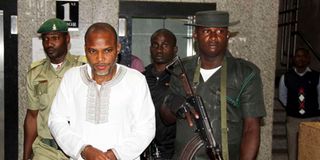The kidnap of exiles in Kenya is an old and complicated story

Nigerian-British separatist leader Nnamdi Kanu attends a trial for treasonable felony at the Federal High Court in Abuja on February 9, 2016.
The story of the alleged kidnapping of Nigerian-British separatist leader Nnamdi Kanu in Nairobi and his transfer to Nigeria just keeps giving. One of the latest accounts, in the US publication Daily Beast, on Monday, quoted witnesses to the public kidnapping of the leader of the Indigenous People of Biafra (IPOB) group as saying he was getting out of his car in the underground parking lot of Jomo Kenyatta International Airport when a group of heavily armed men seized and dragged him to their waiting vehicle.
“As Kanu screamed for help, a number of people who were at the parking lot walked up to the scene and asked the armed men why they were taking the Nigerian, bystanders said. The men then allegedly responded by saying Kanu was a terrorist working for the Somali jihadist group Al-Shabaab, after which they forced him into their vehicle and drove away.
“They didn’t all look Kenyan, and those that spoke didn’t have Kenyan accents,” an airport staffer...said. “I’m not entirely convinced they were from any of Kenya’s security agencies.”
‘Chained to the floor’
Kanu’s lawyer, Aloy Ejimakor, told the BBC that the men drove his client to a private residence, where he was “chained to the floor” and “tortured” for eight days before being blindfolded and flown to Nigeria’s capital, Abuja, in a private jet on June 27, without having to pass through Kenyan passport control. But, outrageous as Kanu’s kidnap might be, the surprise would have been if it hadn’t happened.
One of the most high-profile kidnaps of a dissident in Nairobi happened on February 15, 1999, when Turkish intelligence operatives abducted Abdullah Ocalan, leader of the militant Kurdistan Workers’ Party (PKK) as he was on his way from the Greek embassy in Nation Centre, Nairobi, to JKIA. Much in the fashion of Kanu, Ocalan ended up in Turkey, where a court sentenced him to death, but the penalty was later commuted to life imprisonment.
Lesser known, and carried out on a much larger scale, was the abduction and extradition of Ugandan dissidents in Kenya in the early 1980s as the government of Dr Milton Obote battled rebels led by now-President Yoweri Museveni.
In 1982, Ugandan dissident Balaki Kirya was grabbed from his home in Jamhuri Estate, Nairobi, taken to Wilson Airport and flown to Kisumu. From there, he was driven by road to Uganda through Busia. With several other kidnaps, the big Uganda exile in Kenya fled to Southern Africa and the Nordic and Scandinavian countries.
‘System’
If these events cannot be understood in the moment, how does one make sense of them? Ironically, at one level it reveals about the stability of the Kenyan state at the sub-level. While the political leaders at the top change, and even the men who head the military and intelligence services, the “system” itself doesn’t.
That partly explains why it uses the same playbook of turning a blind eye and allowing the kidnapping of troublesome dissidents, who can be traded for a bigger diplomatic or geopolitical (and even private) gain. It does not always enable the kidnapping of dissidents; it protects them too.
In May 1995, Ugandan journalist Kiwanuka Lawrence Nsereko, who had run afoul of the Museveni government, fled to Kenya. In the book Hounded: African Journalists in Exile, edited by veteran journalist Joseph Odindo, he tells the story of his last days in Kenya before he took off to the US:
“My original plan was to settle in Nairobi and set up a monthly newsmagazine to be distributed back home. But that plan was discarded when Kenyan security arrested Ugandan intelligence officers who had been sent to track me down in Nairobi.
Tension
“The arrests raised tension between the two countries, making it difficult for the Kenyans to continue protecting me. I met the then-powerful minister, Nicholas Biwott, in the suburbs of Nairobi. He advised me to leave as my safety could not be guaranteed.
“Apparently, some elements in the Kenyan government were considering trading me for ‘Brigadier’ John Odongo, leader of a shadowy Uganda-based rebel movement February Eighteenth Revolutionary Army (FERA), which was working to topple Daniel arap Moi. Biwott suggested I go to Australia, where he claimed to have relatives. To this day, I have not understood why Biwott was so kind and concerned about me, quite in contrast with his image as a ruthless politician.
“For the three months I was in Kenya, I was shuttled between safe houses and moved from one church facility to another. I would stay in a slum one day, and in the next I would be in a posh mansion in Muthaiga...just before I was moved to a location near Garissa, some 360 kilometres east of Nairobi. I finally flew out to the United States on August 22, 1995 to begin life as a political exile”.
Nsereko’s story tells you everything you need to know about how this game plays out in Kenya. It has been so for 50 years.
Mr Onyango-Obbo is a journalist, writer and curator of the Wall of Great Africans. @cobbo3





